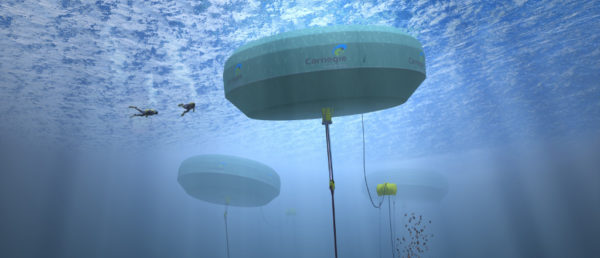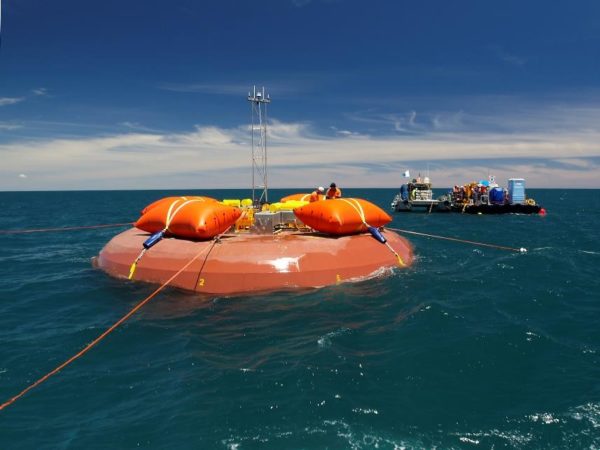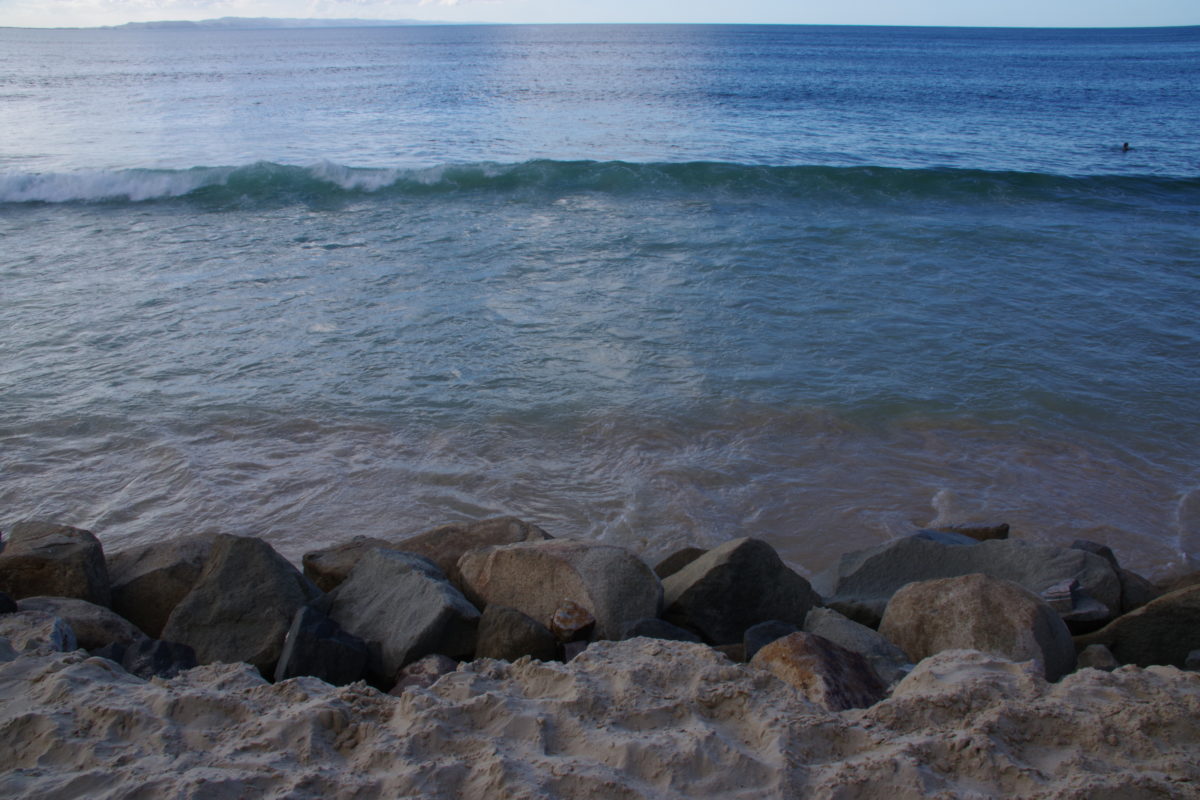The viability of protecting Australia’s coastlines using underwater electricity-generating machines working on the principle of resonance is now being examined as part of a mammoth research project incorporating stakeholders from across the continent.
In February, researchers from Melbourne’s Swinburne University, Adelaide University, and the University of New South Wales announced their collaboration with Victoria’s Moyne Shire Council and Western Australia’s Mid West Ports Authority looking into whether the centuries-old technology concept of wave energy could be recast for our new world.

Image: Carnegie Wave
Wave energy converters
The promise of wave energy is neither new nor mastered. In fact, attempts to harness the ocean’s power document all the way back to 1799. Since then, thousands of patents have been filed and as many inventors risen and fallen. Today, there are about 250 companies tenaciously grappling with the problem, according to Swinburne’s Professor of Fluid Dynamics and project lead, Richard Manasseh.
The first issue wave energy converters face is the nature of wave movements, sucking in and out. “So there’s not a simple and obvious mechanism [to capture that energy], like the turbine,” Professor Manasseh tells pv magazine Australia.
The world is full of inventors though, and many designs have solved this muddle. It is the second hurdle where they fall. “The machines don’t work at all unless they are gigantic,” Manasseh says. “So there’s a mismatch between the amount of capital companies tends to have and the size of what they have to build.”
15 meter's long & bright yellow-no mistaking Bombora’s mWave™ wave energy converter ‘cell module’, transported early on Sunday through Pembroke Dock. Find out more about the 1.5MW mWave Pembrokeshire Demonstration Project. : https://t.co/ZeEg5Thtef#WAVE #energy #EUFundsCymru pic.twitter.com/UOa3tFGrfg
— Bombora (@bomborawave) July 13, 2020
Precisely how big wave energy converters need to be depends on the “frequency” of the wave in the targeted region. Putting aside issue of needing region-specific adjustments, Manasseh says the converters tend to follow two design patterns, though “they all look totally different, so it’s difficult for people to get their heads around.” For the simplicity’s sake, it is enough to say a single machine may be the size of an eight storey building, extending 25 to 30 metres under the sea.
It could cost anywhere from a few hundred thousand to a few million to build, depending on the design’s sophistication and efficiency.
Infrastructure isn’t built for entrepreneurs
It’s hardly surprising then that wave energy has stranded many on the shores of financial ruin. The primary reason for that is not because the designs aren’t good enough or the technology unviable. The issue, Professor Manasseh says, is that our current model for commercialising innovations sees governments take a back seat, letting inventors invent and capitalists provide capital.
'OE Buoy' is a giant wave energy converter, currently being tested out to make sure it can withstand the harsh nature of the #oceans. It has a capacity of 1.25MW.#Innovation #cleanenergy #tech #ClimateChange #technews #cleantech #ActOnClimate #UG4PH #SDGs pic.twitter.com/EvWm8D6TX2
— RD UG4PH (मोदी जी का परिवार) (@DRajesh_UG4PH) July 25, 2020
This pathway doesn’t work for wave energy converters, Manasseh says, because the machines are actually forms of infrastructure, not products. They’re more comparable to highways than wind turbines. “It’s infrastructure that has to be done on a large scale.”
This doesn’t mean the projects have to be paid for by taxpayers, the professor adds, there are many different financial models which could be used – but it does mean that governments need to make the call.
Wave energy real life case study
Since its inception, there have been numerous trials connecting wave energy converters to grids across the world. Many of these have successfully generated electricity, but none have stood the test of time.
That is, all but one important exception: where the technology was used for coastal protection. In the northern Basque region of Spain, the Mutriku harbour was regularly damaged during storms before it built its wave energy infrastructure. The Mutriku project looks like a modified sea wall and Professor Manasseh is quick to point out that is not the design the Australian research project will examine.
Mutriku Wave Energy Plant hits new output milestone generating 2 GWh, never before achieved by any wave power facility. ➡️ https://t.co/e3wgdevXpf #RenewableEnergy #basquecountry pic.twitter.com/LOoX67p6dx
— #euskalenergia (@EVEuskadi) February 24, 2020
Why he thinks it’s important though is firstly because the trial uses the technology in a two-fold way, for protection and electricity generation, and because it is an example of a wave energy project being realised through government backing.
Resonance
A far cry from the blunt technology of a wall, the Australian researchers are looking into using a physics principle called resonance to quell the force of storm waves.
Before we plunge into that concept, build a mental image of a beach in which some 20 or so floating shapes from submerged machines are evenly spaced parallel to the shore. They are not connected, there is no wall or net running between them.
Now we can come back to rather poetic notion of resonance to explain how individual things bobbing in the ocean could be capable of stopping waves.

Image: Western Australian government
Oceans have their own frequency; like a pendulum or swing, it rocks to and fro at a unique pace. Most of the world’s wave energy converter designs tap into this. Engineers can tune wave energy converters like giant musical instruments to have roughly the same natural pace or frequency as the ocean swell, Professor Manasseh says.
“When these frequencies are similar, the machine’s movement becomes very large. It is like pushing a child on a swing: we instinctively push only when the swing reaches at the end of its travel,” he adds. “The arc through which this resonating swing then moves can become very large, and certainly larger than the distance you extend your arms.”
“Likewise, the resonating wave-energy converter moves much more than the water around it, representing wave energy extracted from an area of ocean much larger than the physical size of the machine.”
https://twitter.com/UNSWWRL/status/1492024758049067011
Using resonance, converters maximise the energy they draw from the wave. The other side of this is that by dropping the machines slightly out of resonance, it would be possible to deflect waves by breaking their rhythm.
“Spaced the correct distance apart, [the machines] can effectively function as a wall without touching.”
The key word is control
“Integral to what we are doing is the word: control,” Professor Manasseh says. That is, controlling one fleet of machines well enough for them to be used for two radically different purposes.
“When there’s a storm with potential for a disaster, you probably don’t care at all about generating electricity during that time, so you could potentially operate these machines in a completely different way where you’re not actually extracting power from waves at all, but you are deflecting the waves.”
“If the primary imperative is protecting the coast, it’s not how efficient your electricity generation is, it’s how well you can control the machines.”
Can wave energy converters be used to generate energy, and for coastal protection? Interesting ideas from Rafael Bergillos at @ewtec2019 ! #marine #renewables #renewableenergy #marinescience #climatechange pic.twitter.com/cYuIFl8zCj
— Raeanne Miller (@RaeGMiller) September 3, 2019
Australian research project
Given this, it’s clear wave energy could be as much the domain of governments and stakeholders as of entrepreneurs. Which is why Victoria’s Moyne Shire Council and Western Australia’s Mid West Ports Authority are supporting the Australian research project with both funding and with personnel.
“With wave energy having significant impact on the operations at Mid West Ports, we are eager to work with Swinburne on this research project to identify options that could potentially have dual benefit to our coastline and the operating environment at the port,” Mid West Ports Authority Acting CEO Damian Tully says.
The $2 million project is also being supported by a $436,000 grant from the federal government through the Australian Research Council. While the granularity of the study and the scope of its partnerships are unique, its findings will remain on paper for now.
During its three year evolution, Swinburne researchers will undertake a mathematical modelling exercise to find how well different machine types couple together. Sometime towards the end of this year, they will give those numbers to their control engineering collaborators at Adelaide University.
In Adelaide, the team will start to derive modes of operation, looking at the machine’s electricity generation mode versus its wave blocking modes and tuning their individual settings.
Bombora welcomed @fmwales on a virtual tour to see the world’s most powerful wave energy converter engineered & built in Pembrokeshire. #mWave technology will contribute to our global need for #renewableenergy & create low carbon #Jobs#EUFundsCymru #Netzero #export #SupplyChain pic.twitter.com/krGaidqQTq
— Bombora (@bomborawave) March 9, 2021
The coastal engineering team at the University of New South Wales (UNSW) will then build lab models, essentially dioramas, to simulate how it works while also looking at the movement of sediment. The results of these lab models will then be compared to the predictions generated at Swinburne and Adelaide universities.
At the end, the team is hoping to have a sound understanding of how much such dual purpose project would cost, how much it could save governments and corporations by protecting coastal assets, and how the machines’ modes could be balanced.
The question of how well the machines survive in gnarly ocean conditions remains further down the road. Plus, the 250 odd companies playing in the space are already moving to find answers there.
“There’s been a lot of tech push from the entrepreneurial community over the past 40 plus years, and there’s been fundamental studies similar to ours, but no one has looked at what we’re looking at before: combining power generation with coastal protection and trying to control it,” Manasseh says.
More than $226 billion of Australian assets are exposed to coastal erosion and flooding, with the cost to protect these assets expected to increase. While the question of whether wave sizes will increase with climate change is a complicated one and depends on the hemisphere, it is agreed extremes will become more common, meaning coasts will need all the protection they can get.
This content is protected by copyright and may not be reused. If you want to cooperate with us and would like to reuse some of our content, please contact: editors@pv-magazine.com.









2 comments
By submitting this form you agree to pv magazine using your data for the purposes of publishing your comment.
Your personal data will only be disclosed or otherwise transmitted to third parties for the purposes of spam filtering or if this is necessary for technical maintenance of the website. Any other transfer to third parties will not take place unless this is justified on the basis of applicable data protection regulations or if pv magazine is legally obliged to do so.
You may revoke this consent at any time with effect for the future, in which case your personal data will be deleted immediately. Otherwise, your data will be deleted if pv magazine has processed your request or the purpose of data storage is fulfilled.
Further information on data privacy can be found in our Data Protection Policy.